Key takeaways:
- Classroom engagement enhances student motivation and academic success by connecting lessons to real-life relevance and fostering ownership of learning.
- Interactive and hands-on activities, such as group projects and technology integration, significantly boost student enthusiasm and collaboration.
- Building positive relationships through personal connections and regular check-ins creates a supportive environment where all students feel valued.
- Adapting strategies for diverse learners, such as offering personalized choices and incorporating cultural relevance, unlocks potential and fosters deeper understanding.
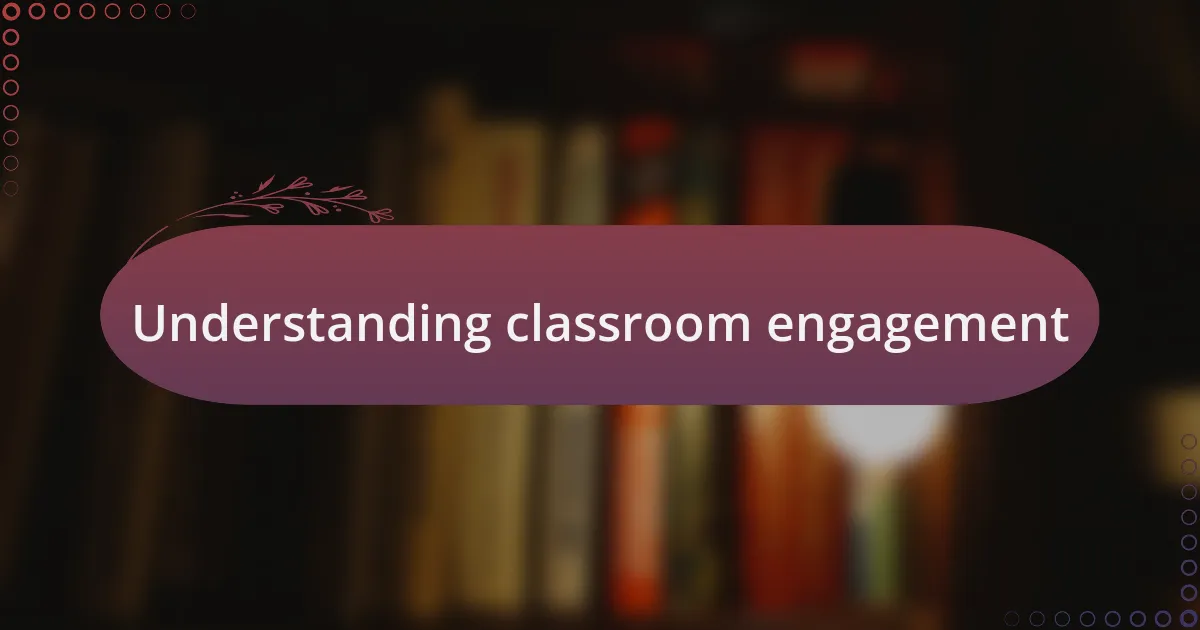
Understanding classroom engagement
Understanding classroom engagement goes beyond just keeping students busy. For me, it’s about fostering an environment where learners feel connected, inspired, and motivated to participate. I recall a time when I introduced group activities that allowed students to lead discussions. The transformation was palpable; suddenly, students who often remained silent began sharing their views with enthusiasm.
Engagement in the classroom often stems from relevance—when students see how the material applies to their lives, they are more likely to invest their attention. I remember a lesson on budgeting where I incorporated real-life scenarios. The students didn’t just hear the concepts; they felt the weight of their decisions, which sparked lively debates and deeper understanding. Have you ever noticed how a simple connection can ignite a passion for learning?
Moreover, classroom engagement isn’t solely about the teacher’s efforts; it’s a two-way street. I’ve seen that when I actively involve students in setting learning goals, their ownership increases significantly. It makes me wonder, shouldn’t we be asking students what they want to learn, instead of deciding for them? Engaging students by valuing their opinions can create a vibrant classroom culture where everyone feels empowered to contribute.

Importance of classroom engagement
Classroom engagement is essential because it directly impacts student motivation and academic success. I’ve often noticed that when learners are actively involved in their education, they show a remarkable increase in their enthusiasm for learning. For instance, during a science project, I asked students to create presentations on topics of their choice. The excitement in the room was infectious, as they eagerly shared their findings and ideas, clearly demonstrating that engagement boosts both knowledge retention and personal investment.
When students feel engaged, they also develop critical social skills. I’ve seen groups come together during collaborative tasks, where they not only share their insights but also learn to respect differing viewpoints. This dynamic creates a strong classroom community. Have you ever experienced that moment when a shy student finally voices an opinion, and the class erupts in support? It’s moments like these that reinforce how deep connections enhance the learning environment.
Moreover, engagement fosters a sense of belonging among students. I remember a particularly challenging period in my classroom, where we took time to share personal stories related to our lessons. This practice allowed students to relate to one another on a deeper level, transforming the classroom into a supportive space. Isn’t it amazing how sharing experiences can strengthen academic and emotional ties? Building engagement isn’t just about curriculum; it’s about cultivating a thriving classroom culture where all voices matter.
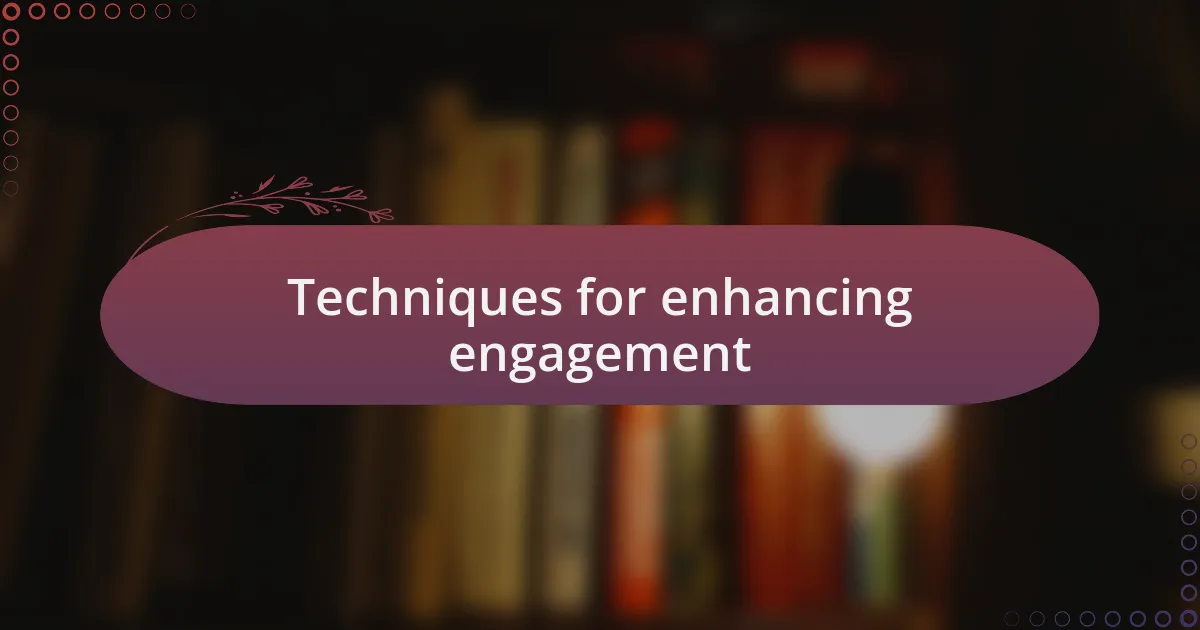
Techniques for enhancing engagement
One technique I’ve found particularly effective is incorporating technology in a way that feels natural and engaging. For example, I introduced interactive quizzes using online platforms, and the students immediately lit up with enthusiasm. Their competitive spirit came alive as they raced to answer questions, creating an energetic atmosphere that made learning feel like a game. Isn’t it incredible how technology can transform a traditional lesson into an exciting challenge?
Another strategy I’ve employed involves the use of hands-on activities. During a recent history unit, we conducted a simulation where students role-played historical figures. I watched as they stepped into their roles with genuine passion, passionately arguing their character’s perspective. It’s amazing how taking on a role allows students to deeply connect with the material, making historical events feel real rather than abstract. Have you ever noticed how full engagement can turn a lesson into a memorable experience?
Additionally, incorporating student choice into assignments has proven invaluable for enhancing engagement. I remember allowing my students to select their own research topics for a project, and the results were astounding. They were not only motivated to dive into their chosen subject matter but also brought unique perspectives to class discussions. It’s fascinating how giving students some autonomy can significantly increase their investment in learning, wouldn’t you agree?
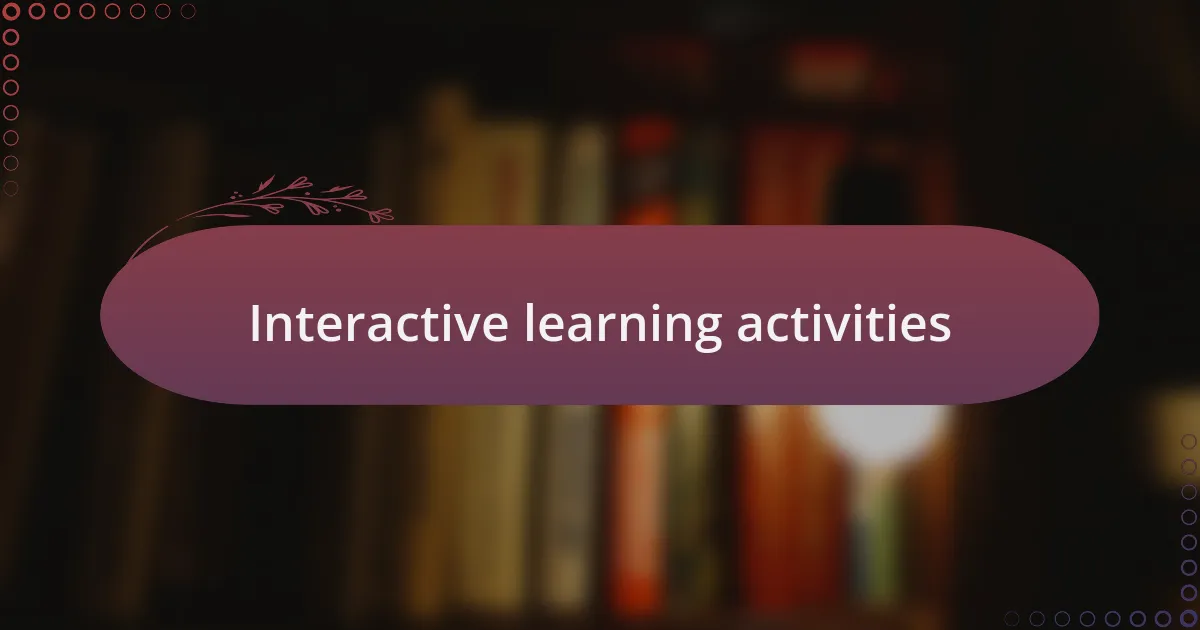
Interactive learning activities
Interactive learning activities often breathe life into the classroom, and I’ve seen firsthand how group projects can spark collaboration among students. For instance, I once organized a science fair where each group presented their experiments. Watching their excitement as they shared findings and fielded questions from peers was truly rewarding. Don’t you think it’s powerful when students learn not just from me, but from each other?
One of my favorite interactive activities is gamification. I’ve developed educational games where students can compete in teams to answer subject-related questions. The energy in the room shifts dramatically; the laughter and friendly banter create a vibrant learning environment. It’s incredible how these games motivate students to absorb information while having fun. Isn’t it delightful to witness learning happen almost effortlessly?
Another impactful method I’ve tried is using technology for collaborative projects. I remember introducing a digital storytelling project that required students to work together online. They chose different platforms to create their narratives, blending images, text, and sound into compelling stories. The pride on their faces when sharing their finished projects was priceless. Have you ever experienced that moment when students take ownership of their learning? It’s truly a game-changer.
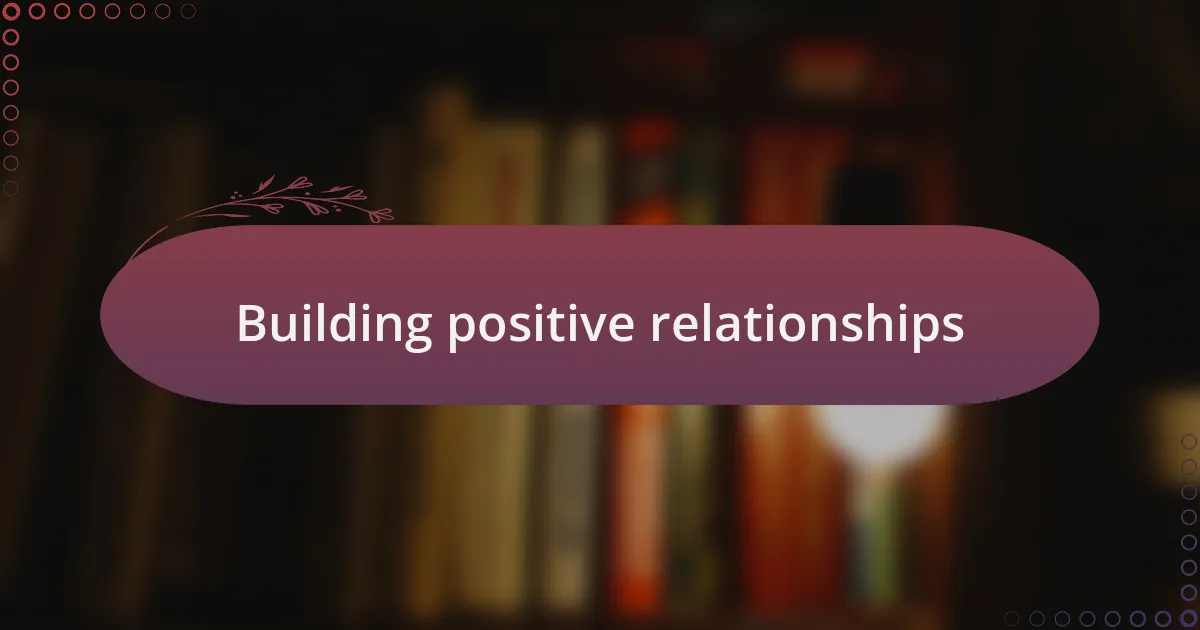
Building positive relationships
Building positive relationships with students is foundational to an engaging classroom. I recall a year when I took the time to learn about each student’s interests and hobbies, which helped me connect with them on a personal level. I remember a student who loved soccer; by casually discussing a recent game, I discovered a shared passion that opened the door to deeper conversations. Isn’t it amazing how knowing just a bit more about our students can foster this sense of belonging?
In another instance, I implemented regular check-ins. At the beginning of each class, I would ask my students how they were feeling—emotionally and academically. It became a ritual that not only encouraged open communication but also helped me understand their challenges. I could sense the relief in their voices when they realized that their feelings were valued. Have you noticed how simply being present can shift the dynamic of your classroom?
Additionally, celebrating individual achievements has been a game changer. I remember allowing students to share their successes, big or small, with the class. One shy student once shared her victory in a local art competition, and you could see the pride illuminate her face. The round of applause that followed not only uplifted her but also strengthened the camaraderie among classmates. How fulfilling is it to create an environment where everyone feels recognized and valued?
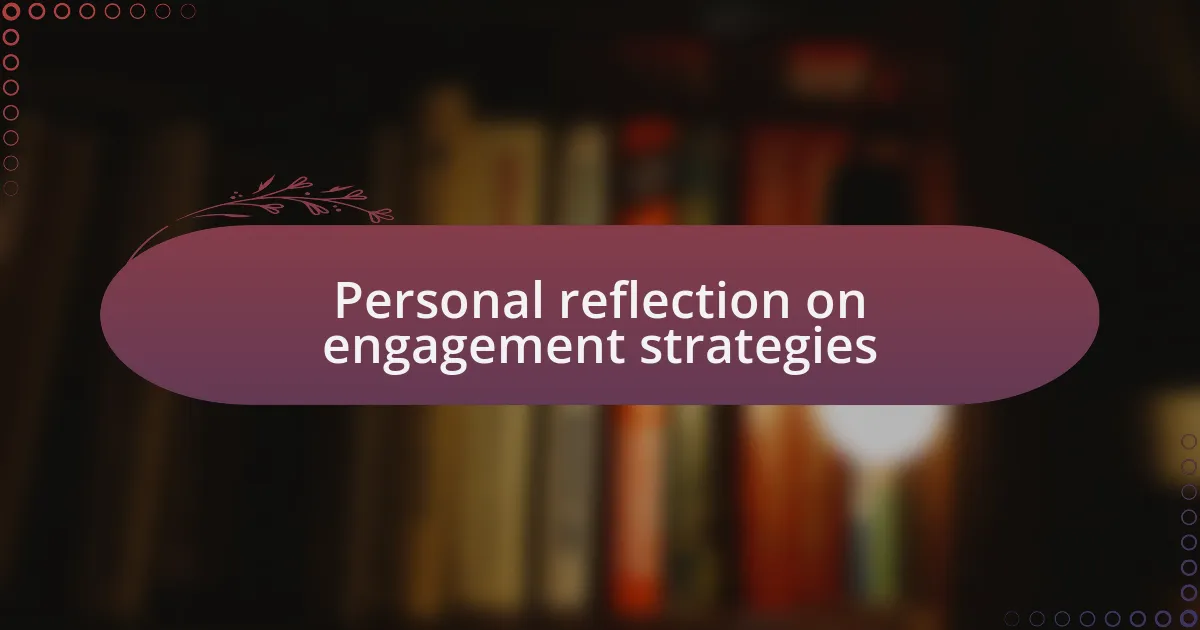
Personal reflection on engagement strategies
When reflecting on my engagement strategies, I often think about the power of hands-on learning. I recall a science project where students built simple machines using everyday materials. Watching their faces light up as they tested their creations made me realize that active participation sparks curiosity. Isn’t it incredible to see students transform from passive listeners to enthusiastic creators?
Another strategy that stands out is the use of collaborative group work. I remember a group of students who initially struggled with math concepts. By pairing them to solve problems together, I noticed how they began to teach one another. It was fascinating to witness this shift in ownership of learning. Have you ever seen how a little teamwork can unlock the potential in students who might otherwise feel overwhelmed?
In my experience, integrating technology has also had a profound impact on engagement. I introduced educational apps that allowed students to explore topics at their own pace. One student, who often hesitated to participate in class discussions, thrived in this setting. She frequently shared her findings with her peers, and her confidence soared. How rewarding is it to witness a student discover their voice through the right tools?
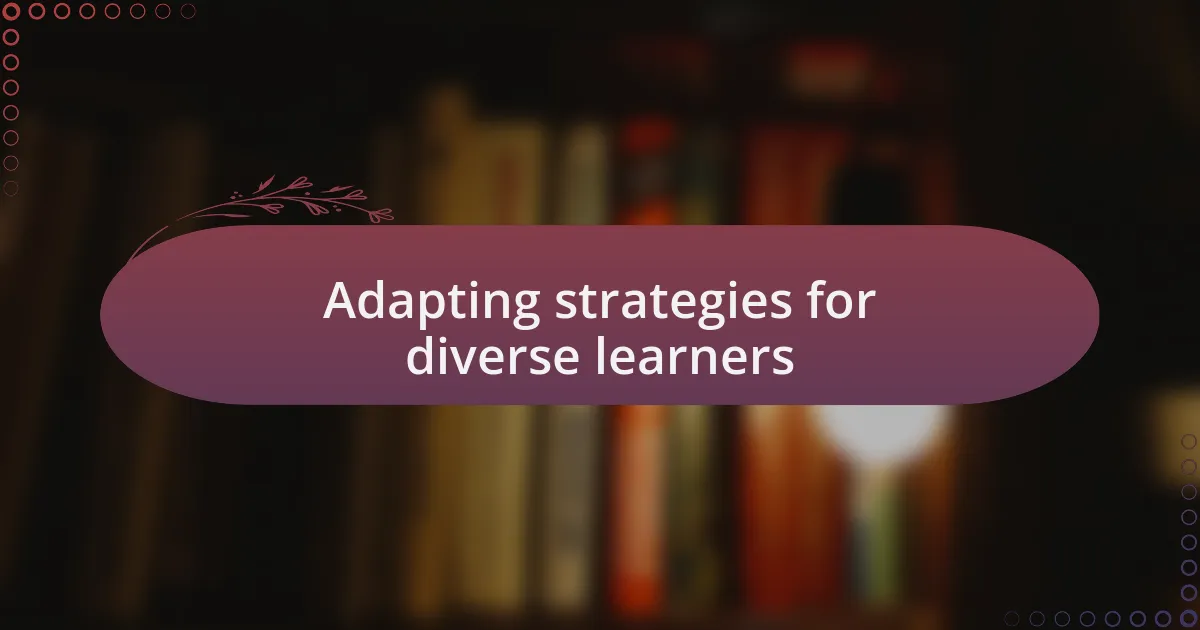
Adapting strategies for diverse learners
To adapt strategies for diverse learners, I find that embracing flexibility is essential. For instance, I once had a student who struggled with traditional reading assignments. By offering options like audiobooks and graphic novels, I was amazed at how this student not only engaged more with the content but also demonstrated a deeper understanding of the material. Have you ever seen how personalized choices can unlock a student’s potential?
In my classroom, differentiating instruction has been a game-changer. I remember implementing tiered assignments in a history lesson, where each student tackled a topic at their skill level. This strategy not only catered to varying abilities but also fostered a sense of accomplishment. Isn’t it inspiring to witness students pushing their boundaries at their own pace?
Moreover, incorporating cultural relevance into lessons has enriched my approach. During a unit on environmental science, I encouraged students to explore local ecosystems through their cultural lenses. One student shared a unique perspective rooted in their heritage, which sparked a classroom discussion that was both insightful and personal. How rewarding it can be when students feel their background influences the learning experience!